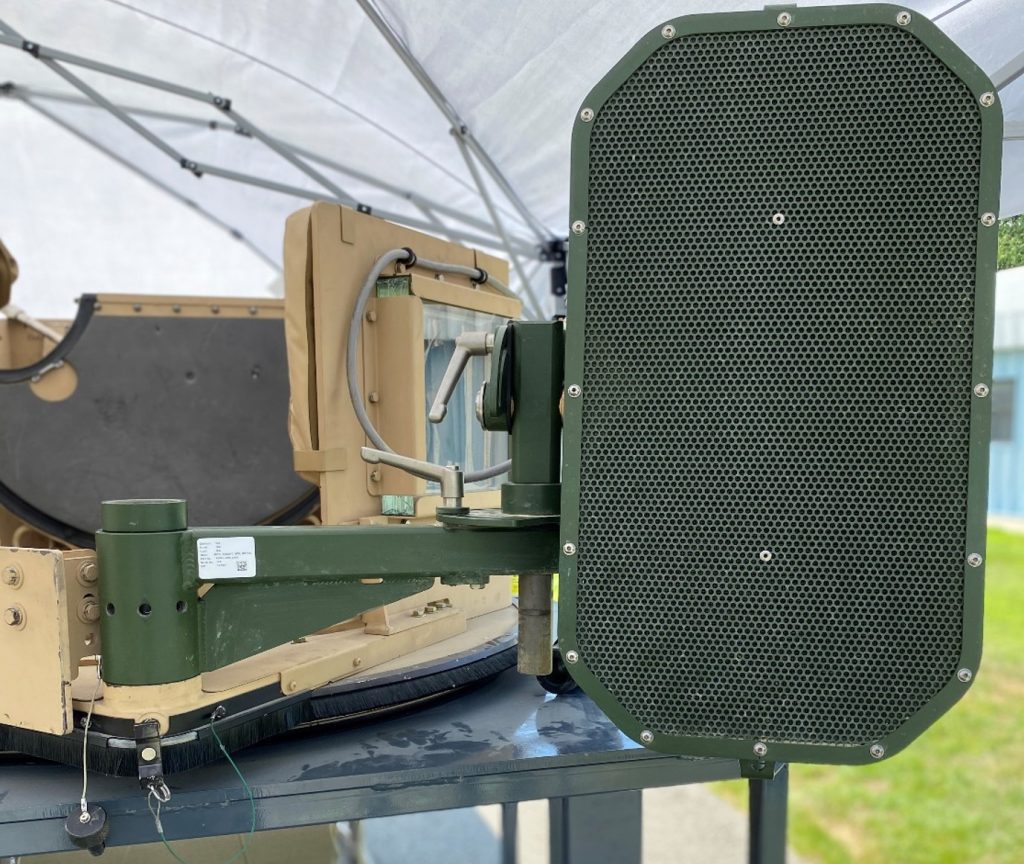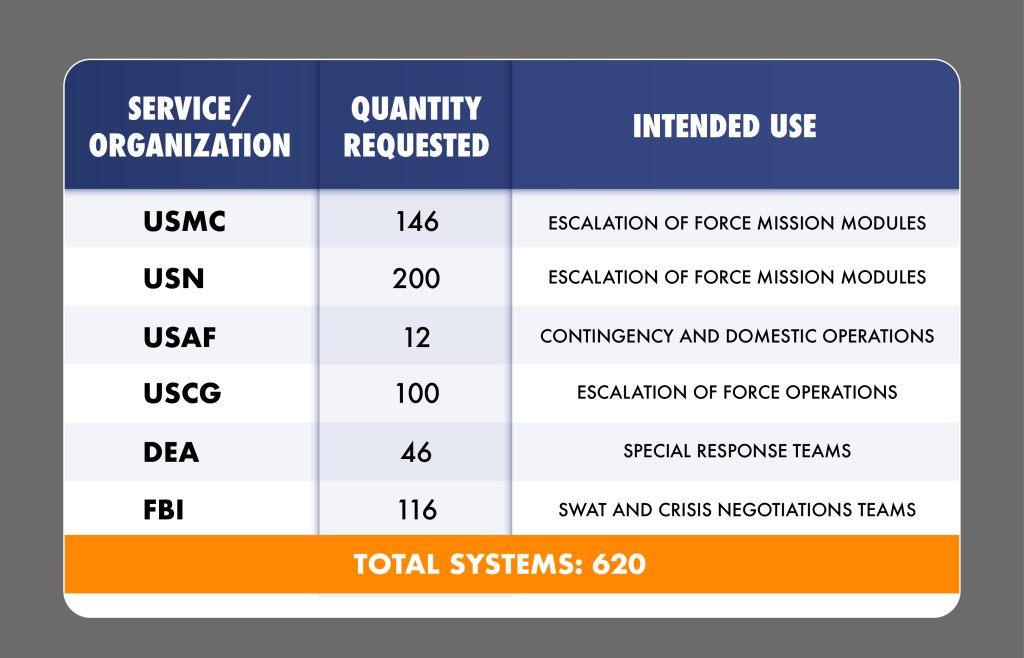
AHD NET: A Soldier from the 8th Theater Sustainment Command at Joint Base Pearl Harbor-Hickam, Hawaii operates the watercraft mounted Acoustic Hailing Device during the New Equipment Training event held June 8, 2021. (Photo by Bryan Miller, instructor, New Equipment Training and Media Production Branch)
Acoustic Hailing Device allows Soldiers to communicate effectively at distance with local populace.
by Lt. Col. (Ret.) Karen Andreeko, Lt. Col. (Ret.) Brett Grosshans, DBA, Derek DeReiter, Tinesha Nicholas and Fred Willecke
Today’s operational forces conduct military operations across a wide spectrum, spanning the gamut from defense support to civil authorities, to peacekeeping and humanitarian assistance, to major combat operations. Operational commanders ask their warfighters to operate under conditions requiring versatile, rapidly deployable forces with the ability to communicate with the local populace at great distances. The Acoustic Hailing Device (AHD), managed by Project Manager Close Combat Systems (PM CCS) as part of its intermediate force capability mission for the Army, within the Joint Program Executive Office for Armaments and Ammunition, provides the Army with a standoff communication capability. This capability has been expanded, with congressional support, to other DOD and government agencies, which optimizes the use of U.S. taxpayer dollars.
THE CHALLENGE
Through the many years of contingency operations, there existed a need to communicate intelligibly over great distances (300-500 meters). Compounding the task was the language barrier created by differing dialects and combatants intermingled with noncombatants. The safety of our warfighters necessitated an increase in the standoff distance between our forces and combatants and noncombatants. This increased distance now requires the ability to determine intent at distances beyond effective small arms range.
THE SOLUTION
Acoustic Hailing Device, or AHD, provides our warfighters the ability to communicate at extended or long-range distances while offering the means to warn those wishing ill intent. Having the ability to communicate before a possible escalation begins means we are working with the local population and not against it, ultimately helping to achieve a positive rapport. Communicating at these greater distances in local dialects helps to ensure force protection needs are addressed while providing a means to deter, mitigate and defeat threats to civilian populations.
The multifaceted team tasked to provide the capability to the user includes:
- Genasys Inc., the primary industry partner of the Army for this technology.
- The S. Army Combat Capabilities Development Command (DEVCOM) Armaments Center and the Product Director, Combat Armaments and Protection Systems (PD CAPS), both out of Picatinny Arsenal, New Jersey.
- The Army Nonlethal Scalable Effects Center at Fort Leonard Wood, Missouri.
The AHD offers a hailing and warning function which produces directional sound waves to project warning tones and intelligible voice commands up to distances of 300 meters over land and 500 meters over water. The system can be mounted via a stationary tripod or on a vehicle to offer mobility and flexibility of maneuver. There are multiple options to communicate: a microphone, prerecorded messages on an MP3 player, or the warning tone. Translation can be achieved by voice over microphone or pre-recorded messages. All aid the warfighter in providing a means to communicate before an escalation of force is required, depending on the scenario, to effectively counter personnel encroaching within a specific area or situation. “The AHD is a tool the commander can use to apply combat power more efficiently—using force only when necessary,” said Col. Russell Hoff, PM CCS.
DOD and the Army have procured AHDs to fulfill the approved requirements for units within the military police, Army watercraft, psychological operations and transportation communities. Extensive platform integration efforts ensured that installation kits were engineered for each specific vehicle and vessel in order to mount the AHD. These Army communities were eager to fill their communication gaps, but other priorities across the Army reduced the available funds. However, in fiscal year 2022, Congress reprioritized $20 million for the AHD program, allowing the Army to procure an additional 500 systems.

DEVICE DEMONSTRATION: The LRAD 450XL, AN-TIC-44(V)1 mounted on the vehicle mount during the Acoustic Hailing Device Logistics Demonstration event at Picatinny Arsenal on July 22, 2020. (Photo by Bryan Henley, instructor, New Equipment Training and Media Production Branch)
THE BENEFIT
The Army’s strategy is to “pure fleet” all Army units that were previously fielded the AN/TIC-43 variant AHD with the latest version of the AHD, the AN/TIC-44 (V)1, using the additional 500 systems. Pure fleeting permits standardization across all Army forces, providing a consistent system for training, and reducing the sustainment burden. By limiting the spares to those required for one system configuration, it reduces the cost required for inventory management in sustainment. In addition, it mitigates the risk of what could be an eventual issue of diminishing manufacturing sources and material shortages. Accordingly, pure fleeting eliminates having to incur the cost of executing a design change or procurement and conducting an effort to update AN/TIC-43s to a new configuration in the future.
The newer variant is of smaller form and provides improved access to the MP3 player and system controls. This allows the operator greater standoff from the system itself, a necessary capability as the speaker could become a target. “Regardless of the operation, if it involves people, clear communication is paramount to safely accomplishing goals,” said Donald Gerspach, the acting central action officer at the Army Nonlethal Scalable Effects Center. “With the AHD, in either form, the user can be assured their communications are being heard.”
The Army’s strategy will allow for turning in the older AN/TIC-43 systems to an Army depot to undergo a complete tech inspection, be repackaged, and be made available to the other services and other government agencies which have expressed an interest in receiving them. A cost benefit of $16 million will be realized for DOD and the other government agencies. Additionally, the Army will realize demilitarization cost savings by making the older systems available for use.

TABLE 1- AGENCY REQUESTS, PROPOSED USAGE: The 2023 agency requests and proposed usage for the Acoustic Hailing Device. The U.S. Army will realize demilitarization cost savings by making the older systems available for use. (Graphic courtesy of PM CCS)
The coordination for this broad approach has been facilitated by the Joint Intermediate Force Capabilities Office (JIFCO) in its role as the executive agent for DOD. JIFCO is tasked, via a joint process, to identify requirements and coordinate the planning, programming and funding of intermediate force capabilities. This is a win-win for the military, government agencies and the American taxpayer.
PREVIOUS USES
The versatility of the system is emphasized during scenarios like search and rescue as well as humanitarian relief efforts, adding value to an already capable technology. Whether enhanced communication is being used to interrogate intent in a military operation, or to locate people, or to provide direction in a disaster area, the AHD has the potential to save lives without causing harm to people, the environment or the infrastructure. The AHD is a simple concept that enhances communications for many. The early versions were used during the aftermath of the Haiti earthquake in 2010; police departments working to contain violent riots; and as a means to keep hostiles and non-hostiles alike away from sensitive areas in theater. The benefits to so many across the military and non-military spectrum showcase what this system has to offer.
CONCLUSION
The Acoustic Hailing Device in either form may be considered an enhancement to the first level of force, which is communication. When communication is better heard and better understood, fewer people are likely to be injured because of confusion and misunderstandings. While most may see the AHD as “just another loudspeaker,” the added capabilities the system brings to the force helps to keep the operator out of harm’s way by increasing the standoff, helping to reduce the confusion through the translation application, and effectively bringing to the user a friendly communication device enabling clear, directional, long-range voice projections. The pure fleet strategy allows AN/TIC-43 to be reutilized by other services and government agencies to address similar capability gaps. The AHD program provides the capability that has been extended by Congressional support to other DOD and other government agencies, which optimizes use of U.S. taxpayer dollars.
For more information, contact Karen Andreeko at karen.l.andreeko.civ@army.mil, or go to the PM CCS website at https://jpeoaa.army.mil/Project-Offices/PM-CCS.
COL. USA (RET.) KAREN ANDREEKO is the project officer for Product Director Combat Armaments and Protection Systems. She has over 30 years of civil service with the U.S. Army providing engineering and program management in research, development, test and evaluation and acquisition for non-lethal systems. She holds a B.S. in health and human services administration from the University of Scranton and is DAWIA certified Advanced in program management.
COL. USMC (RET.) BRETT GROSSHANS, DBA, is a Millennium Corp. support contractor, providing management experience and support to PM CCS for over 17 years. He retired from the U. S. Marine Corps with over 21 years of experience as a rotary wing aviator. He holds a DBA in business administration with focus on homeland security from Walden University, an MBA in project management from Jones International and a B.S. in general science from the University of Iowa. He serves as the senior field coordinator supporting PM CCS at the Futures and Concepts Center, Fort Eustis, Virginia, and manages field coordinators at three additional Army Centers of Excellence, offering guidance and senior leader recommendations to PM CCS leadership on technologies and developing capabilities.
DEREK DEREITER is a team leader for PD CAPS in the Protection Systems portfolio. He started with PM CCS in 2008 and has been working for the PM office for the last 14 years. He started working for the government in March 2003 as an engineer for DEVCOM Armament Center (formerly ARDEC). He brings with him five years of private industry experience working in a manufacturing environment as a project engineer and holds a B.S. in materials science and engineering from Lehigh University.
TINESHA NICHOLAS is the supervisory program management engineer within PM CCS, where she is responsible for leading a diverse portfolio consisting of explosive handheld hazard detection systems, a family of grenades, intermediary force capabilities and nonstandard equipment. She has over 21 years of service as a civilian engineer and program management engineer for the U.S. Army and holds an M.S. and a B.S., both in electrical engineering, from the New Jersey Institute of Technology.
FRED WILLECKE is the chief of product support at PM CCS since August 2018. He holds an MSE (Masters in systems engineering) with Master’s certificates in systems supportability engineering and systems engineering and architecting from Stevens Institute of Technology and a B.A. in political science with a minor in naval science from Villanova University. He is Green Belt certified in Six Sigma and DAWIA certified Advanced in life cycle logistics and a Practitioner in test and evaluation.
Read the full article in the Summer 2023 issue of Army AL&T magazine.Subscribe to Army AL&T – the premier source of Army acquisition news and information.
For question, concerns, or more information, contact us here.







